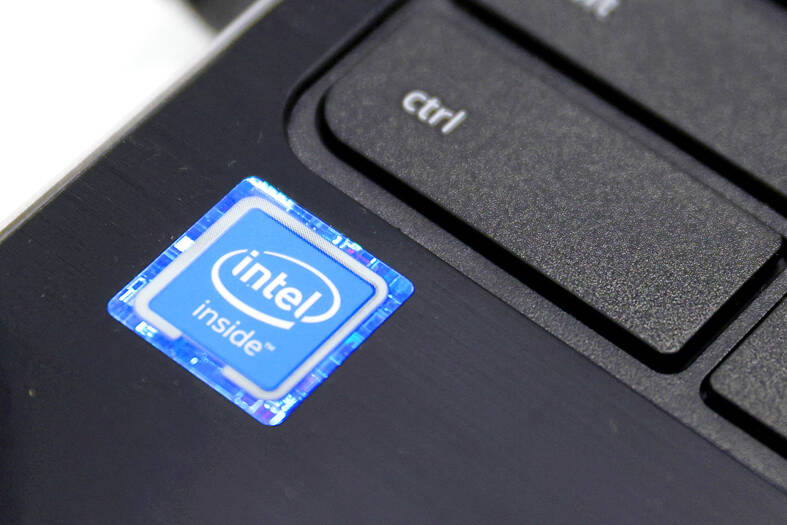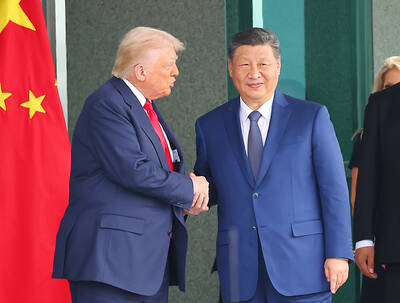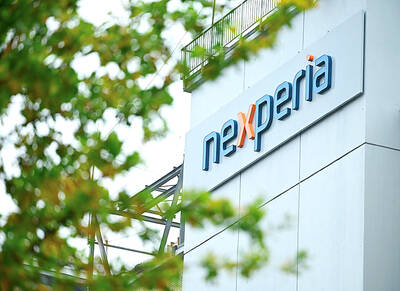Intel Corp on Wednesday announced tech industry veteran Lip-Bu Tan (陳立武) as its new chief executive, boosting shares of the US computer chipmaker struggling to catch up in the artificial intelligence (AI) race. Tan told the Intel team his focus would be on engineering, saying it “won’t be easy” to overcome challenges faced by the company.
Tan, who was born in Malaysia, would start as Intel chief on Tuesday next week, the company said.
Shares were up more than 10 percent in after-market trade.

Photo: REUTERS
Intel is one of Silicon Valley’s most iconic companies, but its fortunes have been eclipsed by Asian powerhouses Taiwan Semiconductor Manufacturing Co (TSMC, 台積電) and Samsung Electronics Co, which dominate the made-to-order semiconductor business. The company was also caught by surprise with the emergence of Nvidia Corp, a graphics chip maker, as the world’s preeminent AI chip provider.
Tan’s predecessor, Pat Gelsinger, was forced out as Intel chief in December last year after the board lost confidence in his plans to turn the company around. Gelsinger’s abrupt departure came just months after the company vowed to cut more than 15,000 jobs in a draconian cost reduction plan and paused or delayed construction on several chipmaking facilities.
“I believe with every fiber of my being that we have what it takes to win,” Tan said in a letter to his team, vowing that Intel would be an engineering-focused company.
“In areas where we are behind the competition, we need to take calculated risks to disrupt and leapfrog,” he said.
While chief of Cadence Design Systems Inc from 2009 to 2021, Tan transformed the company and more than doubled its revenue, according to the Intel board.
Intel last month extended the timeline for completing two new fabrication plants in Ohio, saying it is taking a prudent approach to the US$28 billion project.
The incoming CEO said that he would stick with his predecessor’s plan to make chips for other companies.
“We will work hard to restore Intel’s position as a world-class products company, establish ourselves as a world-class foundry and delight our customers like never before,” he said in the letter. “That’s what this moment demands of us as we remake Intel for the future.”
Plowing ahead with the foundry strategy means taking on TSMC in a market that the Taiwanese company pioneered. TSMC is dominant in the field, churning out chips for clients such as Nvidia, Apple Inc and Advanced Micro Devices Inc.
It is still an open question whether Tan might split up the foundry and chip-design businesses, Raymond James Financial Inc analyst Srini Pajjuri said in a note to clients. Barring that move, Intel would have to demonstrate that it could produce better products.
Members of US President Donald Trump’s administration have floated the idea of TSMC backing a spinoff of Intel’s factory business. However, TSMC’s recent plan to invest US$100 billion in its own factories suggests that it is not aiming to pursue that idea.
“In case of no split, the stock will likely remain a show-me story until investors get a better sense of the company’s manufacturing road map,” Pajjuri said.
In addition, Intel is playing catch-up in the hottest segment of the industry: AI chips for data centers. Nvidia remains dominant in that area.
“Intel lacks an AI narrative,” Pajjuri said. “As such, we remain on the sidelines as we await to hear from the new CEO on his plans for the company.”
Additional reporting by Bloomberg

RUN IT BACK: A succesful first project working with hyperscalers to design chips encouraged MediaTek to start a second project, aiming to hit stride in 2028 MediaTek Inc (聯發科), the world’s biggest smartphone chip supplier, yesterday said it is engaging a second hyperscaler to help design artificial intelligence (AI) accelerators used in data centers following a similar project expected to generate revenue streams soon. The first AI accelerator project is to bring in US$1 billion revenue next year and several billion US dollars more in 2027, MediaTek chief executive officer Rick Tsai (蔡力行) told a virtual investor conference yesterday. The second AI accelerator project is expected to contribute to revenue beginning in 2028, Tsai said. MediaTek yesterday raised its revenue forecast for the global AI accelerator used

TEMPORARY TRUCE: China has made concessions to ease rare earth trade controls, among others, while Washington holds fire on a 100% tariff on all Chinese goods China is effectively suspending implementation of additional export controls on rare earth metals and terminating investigations targeting US companies in the semiconductor supply chain, the White House announced. The White House on Saturday issued a fact sheet outlining some details of the trade pact agreed to earlier in the week by US President Donald Trump and Chinese President Xi Jinping (習近平) that aimed to ease tensions between the world’s two largest economies. Under the deal, China is to issue general licenses valid for exports of rare earths, gallium, germanium, antimony and graphite “for the benefit of US end users and their suppliers

Dutch chipmaker Nexperia BV’s China unit yesterday said that it had established sufficient inventories of finished goods and works-in-progress, and that its supply chain remained secure and stable after its parent halted wafer supplies. The Dutch company suspended supplies of wafers to its Chinese assembly plant a week ago, calling it “a direct consequence of the local management’s recent failure to comply with the agreed contractual payment terms,” Reuters reported on Friday last week. Its China unit called Nexperia’s suspension “unilateral” and “extremely irresponsible,” adding that the Dutch parent’s claim about contractual payment was “misleading and highly deceptive,” according to a statement

Artificial intelligence (AI) giant Nvidia Corp’s most advanced chips would be reserved for US companies and kept out of China and other countries, US President Donald Trump said. During an interview that aired on Sunday on CBS’ 60 Minutes program and in comments to reporters aboard Air Force One, Trump said only US customers should have access to the top-end Blackwell chips offered by Nvidia, the world’s most valuable company by market capitalization. “The most advanced, we will not let anybody have them other than the United States,” he told CBS, echoing remarks made earlier to reporters as he returned to Washington